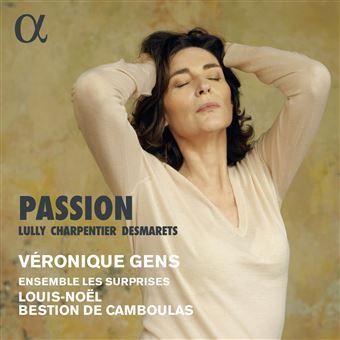Die französische Sopranistin Véronique Gens sang zunächst, in den Achtzigerjahren des 20. Jahrhunderts, Barockmusik. Danach wandte sie sich auch anderen Komponisten zu, von der Klassik über die Romantik bis zum 20 Jahrhundert, immer mit einem Schwerpunkt auf dem französischen Repertoire. Mit dem Programm Passion kehrt sie zu Lully, Charpentier, Desmarets und Collasse zurück und verkörpert die großen Rollen der lyrischen Tragödie des französischen 17. Jahrhunderts (Armide, Arcabonne, Junon, Eolie, Cybèle, Cérès, Médée).
Sie zeigt dabei eine hervorragende Gestaltungskunst, um Leid und Wut, Verzweiflung und Rachegelüste der Figuren auszudrücken. Mit tadelloser Artikulation lässt sie ihre Stimme weich oder auch scharf werden, sie färbt sie immer im Sinne der geforderten Expressivität.
Louis-Noël Bestion de Camboulas hat das 21-teilige Programm als imaginäre Oper konzipiert, so dass die Reihe von Sequenzen eine gewisse musikalische Kontinuität ergibt, an dem neben Véronique Gens der dramatisch und zupackend singende Chor Les Chantres du Centre de Musique Baroque de Versailles und das von Bestion de Camboulas inspiriert und mit viel Ausdruckskraft geleitete Ensemble Les Surpises mitwirken und mit Gens für ein packendes musikalisches Erlebnis sorgen. Das ist Barock in seiner vollen Größe, seiner ganzen Pracht und all seinem Drama.
French soprano Véronique Gens first sang baroque music in the eighties of the 20th century. She then turned to other composers, from the Classical to the Romantic and even the 20th century, always with an emphasis on the French repertoire. With the Passion program, she returns to Lully, Charpentier, Desmarets and Collasse, embodying the great roles of French 17th century lyric tragedy (Armide, Arcabonne, Junon, Eolie, Cybèle, Cérès, Médée).
She shows outstanding artistry in expressing the characters’ suffering and rage, despair and desire for revenge. With impeccable articulation, she lets her voice become soft or sharp, always coloring it in the sense of the required expressivity.
Louis-Noël Bestion de Camboulas conceived the 21-part program as an imaginary opera, so that the series of sequences results in a certain musical continuity, in which, in addition to Véronique Gens, the dramatic and grippingly singing choir Les Chantres du Centre de Musique Baroque de Versailles and the ensemble Les Surpises, led by Bestion de Camboulas with inspiration and expressiveness, provide a gripping musical experience. This is Baroque in all its grandeur, all its splendor and all its drama.


















